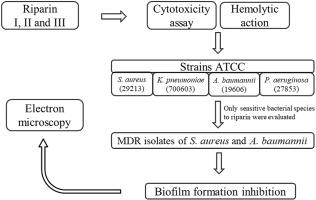Microbial Pathogenesis ( IF 3.8 ) Pub Date : 2020-09-30 , DOI: 10.1016/j.micpath.2020.104529 Jorge Belém Oliveira-Júnior 1 , Everton Morais da Silva 1 , Dyana Leal Veras 1 , Karla Raíza Cardoso Ribeiro 1 , Catarina Fernandes de Freitas 1 , Fernanda Cristina Gomes de Lima 1 , Stanley Juan Chavez Gutierrez 2 , Celso Amorim Camara 3 , José Maria Barbosa-Filho 4 , Luiz Carlos Alves 5 , Fábio André Brayner 5

|
Natural products have been used to treat various infections; however, the development of antimicrobials has made natural products in disuse. Riparin I, II and III are natural alkamide isolated from Aniba riparia (Ness) Mez (Lauraceae), that exhibit economic importance and it is used in traditional medicine, and popularly known as “louro”. This study investigated the cytotoxicity, antimicrobial and antibiofilm activity, and ultrastructural changes in vitro by riparins I, II and III in Staphylococcus aureus, Klebsiella pneumoniae, Acinetobacter baumannii and Pseudomonas aeruginosa. We analyzed the cytotoxicity by MTT assay in Vero cells and hemolytic action verified in human erythrocytes. The antimicrobial activity was determined by microdilution in broth against ATCC strains, identifying the susceptible species. Subsequently, only the MDR isolates of sensitive bacterial species were evaluated regarding its biofilm formation and ultrastructural changes. Riparin I presented low cytotoxicity and hemolytic percentage ranging from of 9.01%–12.97%. Only the riparin III that showed antimicrobial activity against MDR clinical isolates, and significant reduction in biofilm formation in S. aureus. Moreover, the riparin III promoted ultrastructural changes in bacterial cells, such as elongated cellular without bacterial septum, cells with a rugged appearance on the cell surface and cytoplasmic material extravasation. As has been noted riparin III has an inhibitory potential against biofilm formation in S. aureus, besides having antimicrobial activity and promoting ultrastructural changes in MDR clinical isolates. Thus, riparin III is an interesting alternative for further studies aiming to develop new therapeutic options.
中文翻译:

肝素I,II和III的抗菌活性和生物膜抑制作用以及具有医学重要性的耐多药细菌的超微结构变化
天然产品已被用于治疗各种感染。然而,抗微生物剂的开发使天然产品不再使用。Riparin I,II和III是天然ALKAMIDE从隔离Aniba河岸(尼斯)梅茨(樟科),显示出经济上的重要性,它是在传统医学使用,俗称“louro”。这项研究调查了金黄色葡萄球菌,肺炎克雷伯菌,鲍曼不动杆菌和铜绿假单胞菌的肝素I,II和III在体外对肝素I,II和III的细胞毒性,抗微生物和抗生物膜活性以及超微结构的变化。。我们通过MTT分析在Vero细胞中的细胞毒性和在人类红细胞中验证的溶血作用进行了分析。通过在肉汤中对ATCC菌株进行微量稀释来确定其抗菌活性,从而鉴定出易感物种。随后,仅对敏感细菌种类的MDR分离物进行了生物膜形成和超微结构变化的评估。Riparin I具有较低的细胞毒性和溶血百分比,范围为9.01%–12.97%。仅显示对MDR临床分离物具有抗菌活性并显着减少金黄色葡萄球菌生物膜形成的riparin III。此外,riparin III促进了细菌细胞的超微结构变化,例如无细菌隔膜的细长细胞,细胞表面粗糙的细胞和胞质物质外渗。如已经指出的,除了具有抗微生物活性和促进MDR临床分离物中的超微结构变化外,riparin III还具有抑制金黄色葡萄球菌生物膜形成的潜力。因此,对于进一步研究以开发新的治疗选择为目的的,肝素III是一个有趣的替代品。



























 京公网安备 11010802027423号
京公网安备 11010802027423号